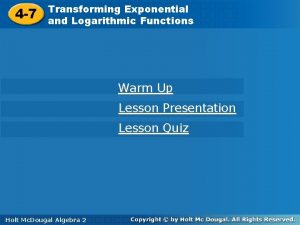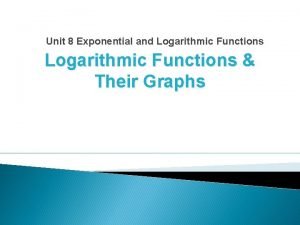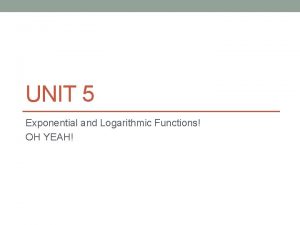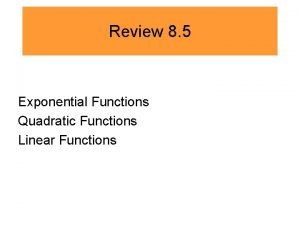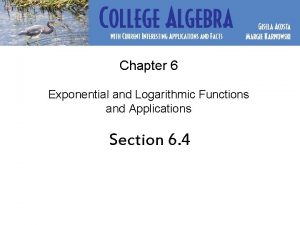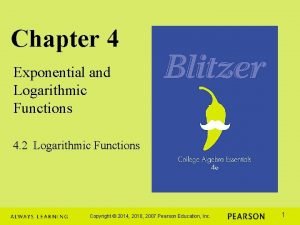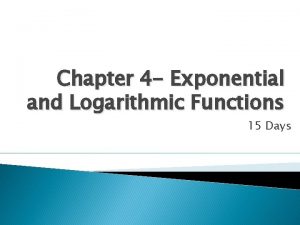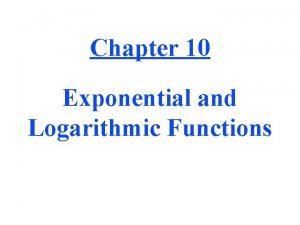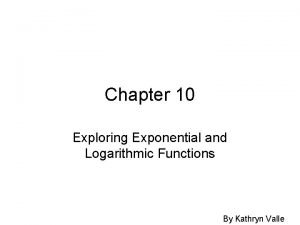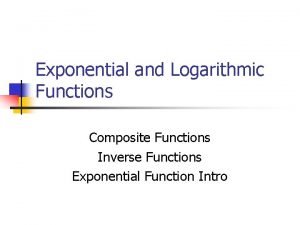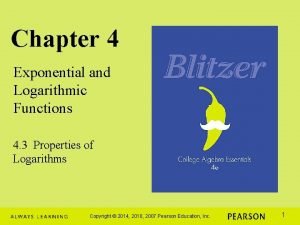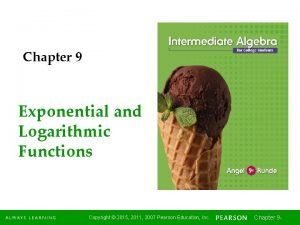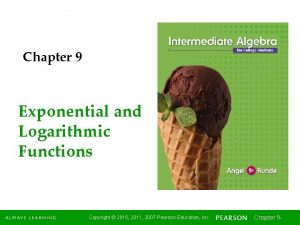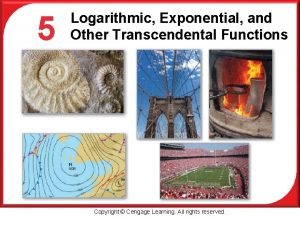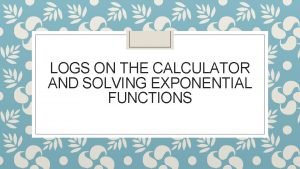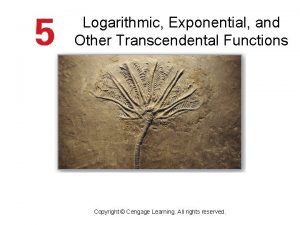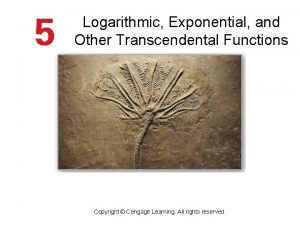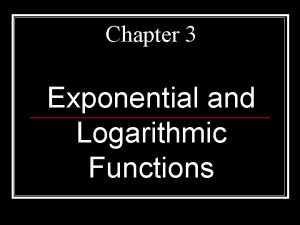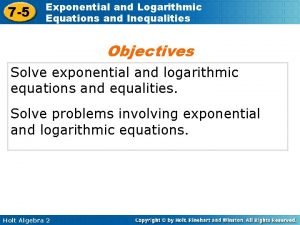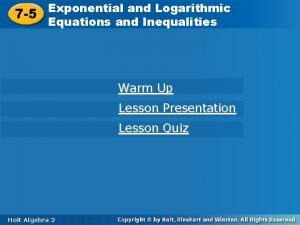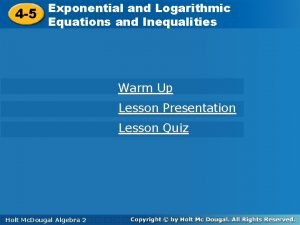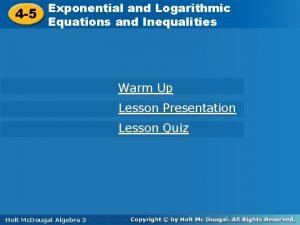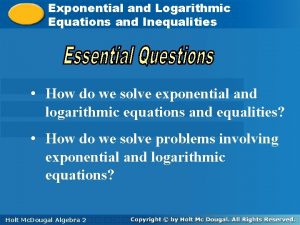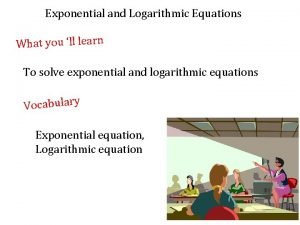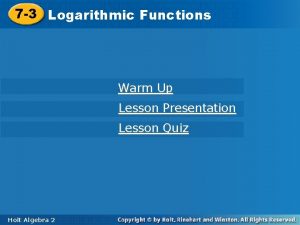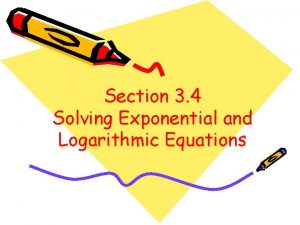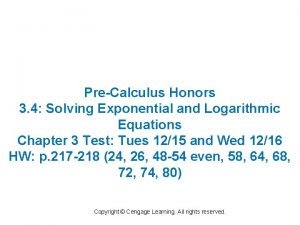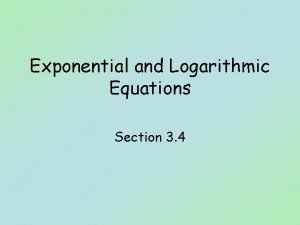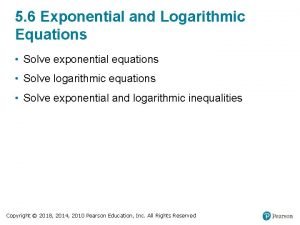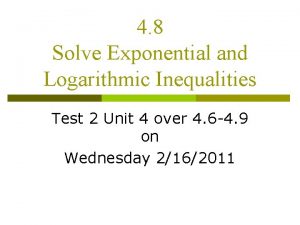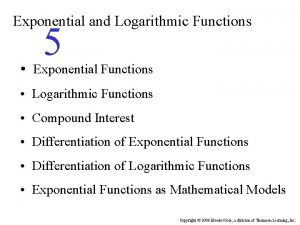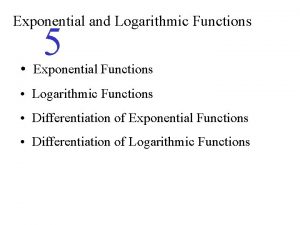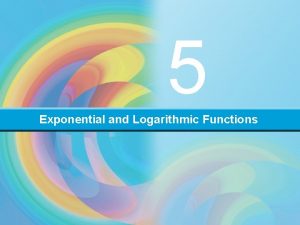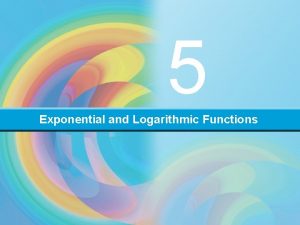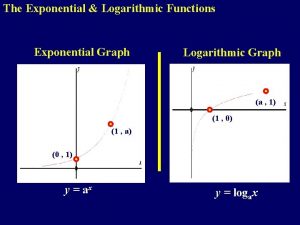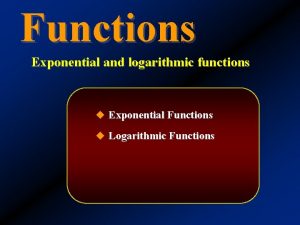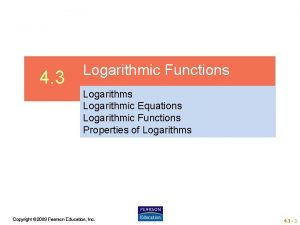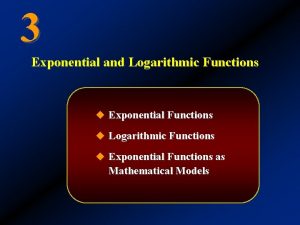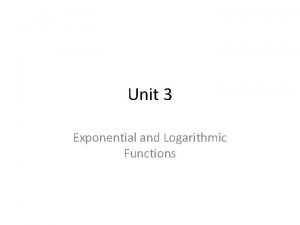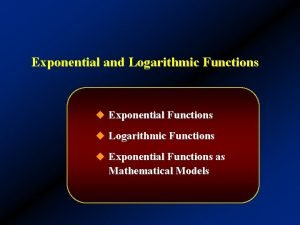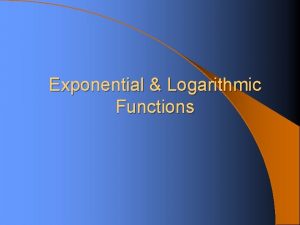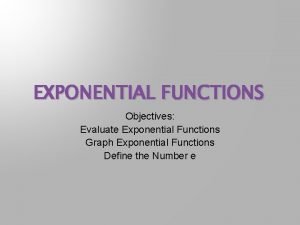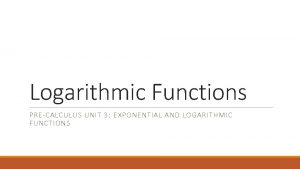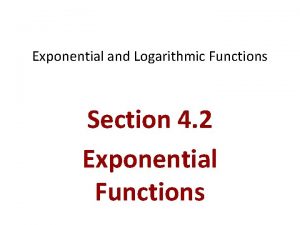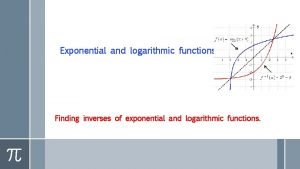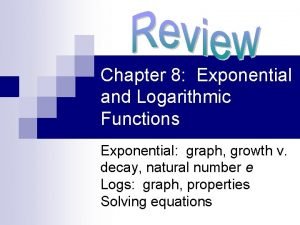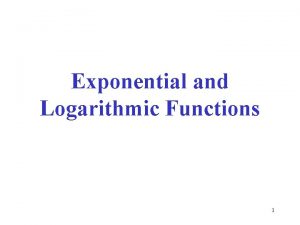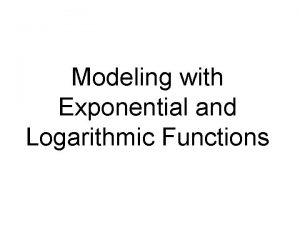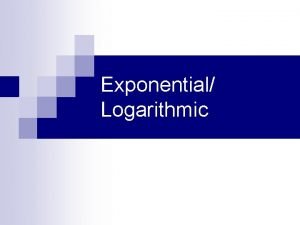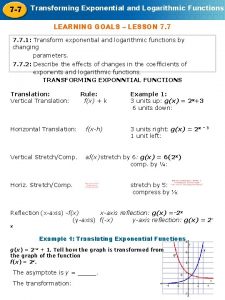4 7 Transforming Exponential and Logarithmic Functions Warm



































- Slides: 35

4 -7 Transforming Exponential and Logarithmic Functions Warm Up Lesson Presentation Lesson Quiz Holt Mc. Dougal Algebra 2 Algebra 22 Holt Mc. Dougal

4 -7 Transforming Exponential and Logarithmic Functions Warm Up How does each function compare to its parent function? 1. f(x) = 2(x – 3)2 – 4 vertically stretched by a factor of 2, translated 3 units right, translated 4 units down 2. g(x) = (–x)3 + 1 reflected across the y-axis, translated 1 unit up Holt Mc. Dougal Algebra 2

4 -7 Transforming Exponential and Logarithmic Functions Objectives Transform exponential and logarithmic functions by changing parameters. Describe the effects of changes in the coefficients of exponents and logarithmic functions. Holt Mc. Dougal Algebra 2

4 -7 Transforming Exponential and Logarithmic Functions You can perform the same transformations on exponential functions that you performed on polynomials, quadratics, and linear functions. Holt Mc. Dougal Algebra 2

4 -7 Transforming Exponential and Logarithmic Functions Holt Mc. Dougal Algebra 2

4 -7 Transforming Exponential and Logarithmic Functions Helpful Hint It may help you remember the direction of the shift if you think of “h is for horizontal. ” Holt Mc. Dougal Algebra 2

4 -7 Transforming Exponential and Logarithmic Functions Example 1: Translating Exponential Functions Make a table of values, and graph g(x) = 2–x + 1. Describe the asymptote. Tell how the graph is transformed from the graph of the function f(x) = 2 x. x – 3 – 2 – 1 0 1 2 g(x) 9 5 3 2 1. 5 1. 25 The asymptote is y = 1, and the graph approaches this line as the value of x increases. The transformation reflects the graph across the y-axis and moves the graph 1 unit up. Holt Mc. Dougal Algebra 2

4 -7 Transforming Exponential and Logarithmic Functions Check It Out! Example 1 Make a table of values, and graph f(x) = 2 x – 2. Describe the asymptote. Tell how the graph is transformed from the graph of the function f(x) = 2 x. x f(x) – 2 – 1 0 1 16 1 8 1 4 1 1 2 2 1 The asymptote is y = 0, and the graph approaches this line as the value of x decreases. The transformation moves the graph 2 units right. Holt Mc. Dougal Algebra 2

4 -7 Transforming Exponential and Logarithmic Functions Example 2: Stretching, Compressing, and Reflecting Exponential Functions Graph the function. Find yintercept and the asymptote. Describe how the graph is transformed from the graph of its parent function. A. g(x) = 2 (1. 5 x) 3 parent function: f(x) = 1. 5 x The graph of g(x) is a vertical compression of y-intercept: 2 3 the parent function f(x) asymptote: y = 0 2 1. 5 x by a factor of 3. Holt Mc. Dougal Algebra 2

4 -7 Transforming Exponential and Logarithmic Functions Example 2: Stretching, Compressing, and Reflecting Exponential Functions B. h(x) = e–x + 1 parent function: f(x) = ex y-intercept: e asymptote: y = 0 The graph of h(x) is a reflection of the parent function f(x) = ex across the y-axis and a shift of 1 unit to the right. The range is {y|y > 0}. Holt Mc. Dougal Algebra 2

4 -7 Transforming Exponential and Logarithmic Functions Check It Out! Example 2 a Graph the exponential function. Find y-intercept and the asymptote. Describe how the graph is transformed from the graph of its parent function. h(x) = 1 (5 x) 3 parent function: f(x) = 5 x The graph of h(x) is a vertical compression of 1 y-intercept 3 the parent function f(x) asymptote: 0 = 5 x by a factor of 1. 3 Holt Mc. Dougal Algebra 2

4 -7 Transforming Exponential and Logarithmic Functions Check It Out! Example 2 b g(x) = 2(2–x) parent function: f(x) = 2 x y-intercept: 2 asymptote: y = 0 The graph of g(x) is a reflection of the parent function f(x) = 2 x across the y-axis and vertical stretch by a factor of 2. Holt Mc. Dougal Algebra 2

4 -7 Transforming Exponential and Logarithmic Functions Because a log is an exponent, transformations of logarithm functions are similar to transformations of exponential functions. You can stretch, reflect, and translate the graph of the parent logarithmic function f(x) = logbx. Holt Mc. Dougal Algebra 2

4 -7 Transforming Exponential and Logarithmic Functions Examples are given in the table below for f(x) = logx. Holt Mc. Dougal Algebra 2

4 -7 Transforming Exponential and Logarithmic Functions Remember! Transformations of ln x work the same way because lnx means logex. Holt Mc. Dougal Algebra 2

4 -7 Transforming Exponential and Logarithmic Functions Example 3 A: Transforming Logarithmic Functions Graph each logarithmic function. Find the asymptote. Describe how the graph is transformed from the graph of its parent function. g(x) = 5 log x – 2 asymptote: x = 0 The graph of g(x) is a vertical stretch of the parent function f(x) = log x by a factor of 5 and a translation 2 units down. Holt Mc. Dougal Algebra 2

4 -7 Transforming Exponential and Logarithmic Functions Example 3 B: Transforming Logarithmic Functions Graph each logarithmic function. Find the asymptote. Describe how the graph is transformed from the graph of its parent function. h(x) = ln(–x + 2) asymptote: x = 2 The graph of h(x) is a reflection of the parent function f(x) = ln x across the y-axis and a shift of 2 units to the right. D: {x|x < 2} Holt Mc. Dougal Algebra 2

4 -7 Transforming Exponential and Logarithmic Functions Check It Out! Example 3 Graph the logarithmic p(x) = –ln(x + 1) – 2. Find the asymptote. Then describe how the graph is transformed from the graph of its parent function. asymptote: x = – 1 The graph of p(x) is a reflection of the parent function f(x) = ln x across the x-axis 1 unit left and a shift of 2 units down. Holt Mc. Dougal Algebra 2

4 -7 Transforming Exponential and Logarithmic Functions Example 4 A: Writing Transformed Functions Write each transformed function. f(x) = 4 x is reflected across both axes and moved 2 units down. 4 x Begin with the parent function. 4–x To reflect across the y-axis, replace x with –x. –(4–x) To reflect across the x-axis, multiply the function by – 1. g(x)= –(4–x) – 2 Holt Mc. Dougal Algebra 2 To translate 2 units down, subtract 2 from the function.

4 -7 Transforming Exponential and Logarithmic Functions Example 4 B: Writing Transformed Functions f(x) = ln x is compressed horizontally by a factor of 1 and moved 3 units left. 2 g(x) = ln 2(x + 3) When you write a transformed function, you may want to graph it as a check. Holt Mc. Dougal Algebra 2

4 -7 Transforming Exponential and Logarithmic Functions Check It Out! Example 4 Write the transformed function when f(x) = log x is translated 3 units left and stretched vertically by a factor of 2. g(x) = 2 log(x + 3) When you write a transformed function, you may want to graph it as a check. Holt Mc. Dougal Algebra 2

4 -7 Transforming Exponential and Logarithmic Functions Example 5: Problem-Solving Application The temperature in o. F that milk must be kept at to last n days can be modeled by T(n) = 75 – 16 ln n. Describe how the model is transformed from f(n) = ln n. Use the model to predict how long milk will last if kept at 34 o. F. Holt Mc. Dougal Algebra 2

4 -7 Transforming Exponential and Logarithmic Functions Example 5 Continued 1 Understand the Problem The answers will be the description of the transformations in T(n) = 75 – 16 ln n and the number of days the milk will last if kept at 34 o. F. List the important information: • The model is the function T(n) = 75 – 16 ln n. • The function is a transformation of f(n) = ln n. • The problem asks for n when T is 34. Holt Mc. Dougal Algebra 2

4 -7 Transforming Exponential and Logarithmic Functions Example 5 Continued 2 Make a Plan Rewrite the function in a more familiar form, and then use what you know about the effect of changing the parent function to describe the transformations. Substitute known values into T(n) = 75 – 16 ln n, and solve for the unknown. Holt Mc. Dougal Algebra 2

Transforming Exponential and Logarithmic Functions 4 -7 Example 5 Continued 3 Solve Rewrite the function, and describe the transformations. T(n) = 75 – 16 ln n Commutative Property T(n) = – 16 ln n + 75 The graph of f(n) = ln n is reflected across the x-axis, vertically stretched by a factor of 16, and translated 75 units up. Holt Mc. Dougal Algebra 2

Transforming Exponential and Logarithmic Functions 4 -7 Example 5 Continued 3 Solve Find the number of days the milk will last at 34 o. F. 34 = – 16 ln n + 75 Substitute 34 for T(n). – 41 = – 16 ln n Subtract 75 from both sides. – 41 = ln n – 16 Divide by – 16. e 41 16 =n Change to exponential form. n ≈ 13 The model predicts that the milk will last about 13 days. Holt Mc. Dougal Algebra 2

4 -7 Transforming Exponential and Logarithmic Functions Example 5 Continued 4 Look Back It is reasonable that milk would last 13 days if kept at 34 o. F. Holt Mc. Dougal Algebra 2

4 -7 Transforming Exponential and Logarithmic Functions Check It Out! Example 5 A group of students retake the written portion of a driver’s test after several months without reviewing the material. A model used by psychologists describes retention of the material by the function a(t) = 85 – 15 log(t + 1), where a is the average score at time t (in months). Describe how the model is transformed from its parent function. When would the average score drop below 0. Is your answer reasonable? Holt Mc. Dougal Algebra 2

4 -7 Transforming Exponential and Logarithmic Functions Check It Out! Example 5 Continued 1 Understand the Problem The answers will be the description of the transformations in a(t) = 85 – 15 log(t + 1) and the number of months when the score falls below 0. List the important information: • The model is the function a(t) = 85 – 15 log (t + 1). • The function is a transformation of f(t) = log(t). • The problem asks for t when t = 0. Holt Mc. Dougal Algebra 2

4 -7 Transforming Exponential and Logarithmic Functions Check It Out! Example 5 Continued 2 Make a Plan Rewrite the function in a more familiar form, and then use what you know about the effect of changing the parent function to describe the transformations. Substitute known values into a(t) = 85 – 15 log(t + 1), and solve for the unknown. Holt Mc. Dougal Algebra 2

4 -7 Transforming Exponential and Logarithmic Functions Check It Out! Example 5 Continued 3 Solve Rewrite the function, and describe the transformations. a(t) = 85 – 15 log(t + 1) a(t) = – 15 log(t + 1) + 85 Commutative Property The graph of f(t) = ln n is reflected across the x-axis, vertically stretched by a factor of 15, and translated 85 units up and 1 unit left. Holt Mc. Dougal Algebra 2

4 -7 Transforming Exponential and Logarithmic Functions Check It Out! Example 5 Continued 3 Solve Find the time when the average score drops to 0. 0 = – 15 log(t+1) + 85 Substitute 0 for a(t). – 85 = – 15 log(t + 1) 5. 67 = log(t + 1) 105. 6667 = t + 1 464, 194 ≈ t 38, 683 ≈ t Holt Mc. Dougal Algebra 2 Subtract 85 from both sides. Divide by – 15. Change to exponential form. Change from months to years.

4 -7 Transforming Exponential and Logarithmic Functions Check It Out! Example 5 Continued 4 Look Back It is unreasonable that scores would drop to zero 38, 683 years after the students take the test without reviewing the material. Holt Mc. Dougal Algebra 2

4 -7 Transforming Exponential and Logarithmic Functions Lesson Quiz: Part I 1. Graph g(x) = 20. 25 x – 1. Find the asymptote. Describe how the graph is transformed from the graph of its parent function. y = – 1; the graph of g(x) is a horizontal stretch of f(x) = 2 x by a factor of 4 and a shift of 1 unit down. Holt Mc. Dougal Algebra 2

4 -7 Transforming Exponential and Logarithmic Functions Lesson Quiz: Part II 2. Write the transformed function: f(x) = ln x is stretched by a factor of 3, reflected across the x -axis, and shifted by 2 units left. g(x) = – 3 ln(x + 2) Holt Mc. Dougal Algebra 2
 Transforming exponential and logarithmic functions
Transforming exponential and logarithmic functions Unit 8 review logarithms
Unit 8 review logarithms Examples of exponential equations
Examples of exponential equations Difference between quadratic and exponential
Difference between quadratic and exponential Chapter 6 exponential and logarithmic functions answers
Chapter 6 exponential and logarithmic functions answers Chapter 4 exponential and logarithmic functions
Chapter 4 exponential and logarithmic functions Graphing logs and exponentials worksheet
Graphing logs and exponentials worksheet Pert formula
Pert formula Chapter 10 exponential and logarithmic functions answers
Chapter 10 exponential and logarithmic functions answers Composite exponential function
Composite exponential function Lesson 5-2
Lesson 5-2 Chapter 4 exponential and logarithmic functions
Chapter 4 exponential and logarithmic functions Chapter 9 exponential and logarithmic functions answer key
Chapter 9 exponential and logarithmic functions answer key Chapter 9 exponential and logarithmic functions answer key
Chapter 9 exponential and logarithmic functions answer key Chapter 5 exponential and logarithmic functions answer key
Chapter 5 exponential and logarithmic functions answer key Logarithmic exponential and other transcendental functions
Logarithmic exponential and other transcendental functions Exponential function calculator
Exponential function calculator Chapter 5 logarithmic exponential and other
Chapter 5 logarithmic exponential and other Integration of exponential
Integration of exponential Chapter 5 exponential and logarithmic functions
Chapter 5 exponential and logarithmic functions Chapter 3 exponential and logarithmic functions
Chapter 3 exponential and logarithmic functions Log to exponential
Log to exponential 7-5 exponential and logarithmic equations and inequalities
7-5 exponential and logarithmic equations and inequalities Exponential and logarithmic inequalities
Exponential and logarithmic inequalities Exponential equations examples
Exponential equations examples Exponential and logarithmic equations and inequalities
Exponential and logarithmic equations and inequalities Modeling with exponential and logarithmic equations quiz
Modeling with exponential and logarithmic equations quiz 7-3 lesson quiz
7-3 lesson quiz 3-4 exponential and logarithmic equations
3-4 exponential and logarithmic equations 3-4 exponential and logarithmic equations
3-4 exponential and logarithmic equations Logarithm
Logarithm Curve fitting with exponential and logarithmic models
Curve fitting with exponential and logarithmic models 3-4 exponential and logarithmic equations
3-4 exponential and logarithmic equations Solving exponential inequality
Solving exponential inequality Solve logarithmic equations
Solve logarithmic equations What is logarithmic inequality
What is logarithmic inequality
